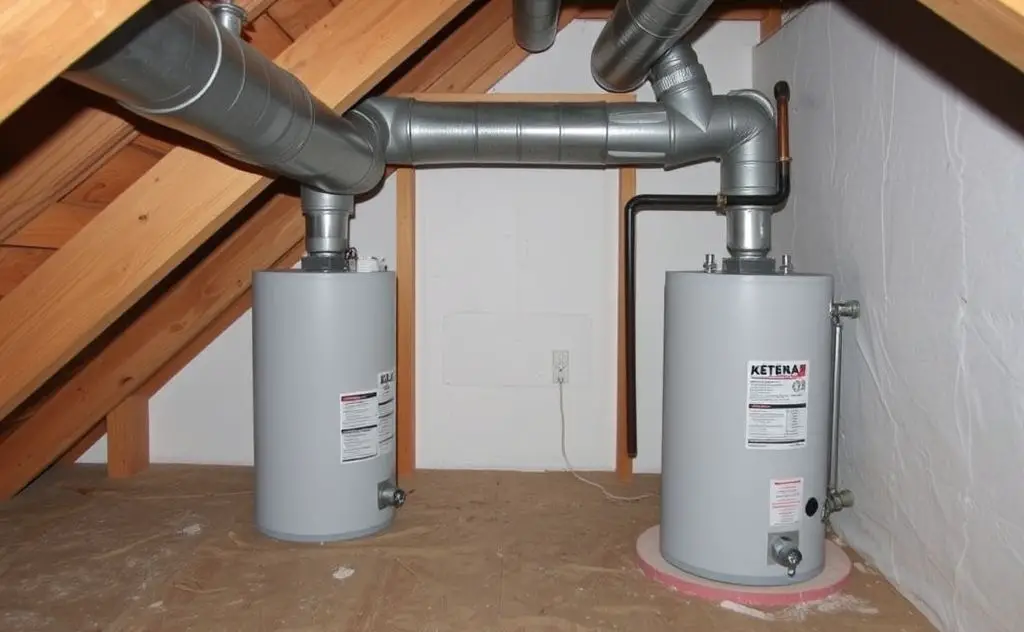No, you should not vent a gas water heater into the attic as it can cause dangerous gas buildup and violate safety codes.
Venting a gas water heater into an attic is a serious safety hazard that violates building codes. This dangerous practice can lead to carbon monoxide poisoning, fire risks, and equipment failure. Homeowners must address this issue immediately to protect their families.

Why Attic Venting Is Dangerous
Gas water heaters produce combustion gases that must be properly vented outdoors. When vented into an attic, these toxic gases can accumulate and create life-threatening situations.
Carbon Monoxide Poisoning Risk
Improper venting allows carbon monoxide (CO) to build up in your home. CO is odorless and colorless, making it impossible to detect without alarms. According to the CDC, over 400 Americans die annually from unintentional CO poisoning.
Fire Hazard
The exhaust from gas water heaters reaches extremely high temperatures. When vented into an attic filled with insulation and wood framing, this creates significant fire risks. The National Fire Protection Association reports heating equipment causes 15% of home structure fires annually.
Moisture Damage
Combustion gases contain water vapor that condenses in cooler attic spaces. This moisture leads to mold growth, wood rot, and insulation degradation. Over time, it can compromise your roof structure.

Proper Venting Requirements
Building codes strictly regulate gas appliance venting to ensure safety. The International Residential Code (IRC) specifies:
- Vents must terminate outdoors, not in attics or crawlspaces
- Minimum clearance from combustible materials
- Proper slope and support for vent pipes
- Adequate combustion air supply
Direct Vent Systems
Modern built-in gas heaters often use direct vent technology. These sealed systems draw combustion air from outside and exhaust directly through an exterior wall or roof. They’re ideal for attics and tight spaces.
Power Vent Options
Power vent water heaters use fans to push exhaust gases through PVC piping. This allows more flexible installation locations while maintaining safety. They’re slightly more expensive but solve many venting challenges.
Solutions for Improper Attic Venting
If your gas water heater vents into the attic, take immediate action:
- Install carbon monoxide detectors on every floor
- Contact a licensed plumber for inspection
- Consider upgrading to a tankless water heater with proper venting
- Have the vent system rerouted to terminate outdoors
Professional Assessment
A qualified technician should evaluate your entire system. They’ll check for:
| Item | Check |
|---|---|
| Vent material | Proper type and condition |
| Termination point | Outside the building |
| Draft | Proper exhaust flow |
| Clearances | From combustibles |
Alternative Water Heater Options
For homes with challenging venting situations, consider these alternatives:
Electric Water Heaters
Electric models don’t require venting, eliminating attic venting concerns. While operating costs may be higher, installation is simpler in tight spaces.
Heat Pump Water Heaters
These ultra-efficient units extract heat from surrounding air. They cost more upfront but can cut water heating costs by 50-60% according to energy.gov.
Condensing Water Heaters
High-efficiency condensing models capture exhaust heat and vent through PVC pipes. They’re more expensive but offer excellent performance and flexible venting options.
Building Code Compliance
All water heater installations must meet local building codes. Key requirements include:
- Approved vent materials (stainless steel, AL29-4C, or PVC for power vents)
- Minimum 12-inch clearance from combustibles for single-wall vents
- 1/4-inch per foot upward slope toward termination
- Proper support every 5 feet for horizontal runs
Never attempt to modify venting yourself. Always hire a licensed professional familiar with local codes and manufacturer specifications. Your family’s safety depends on proper installation and venting of gas appliances.

